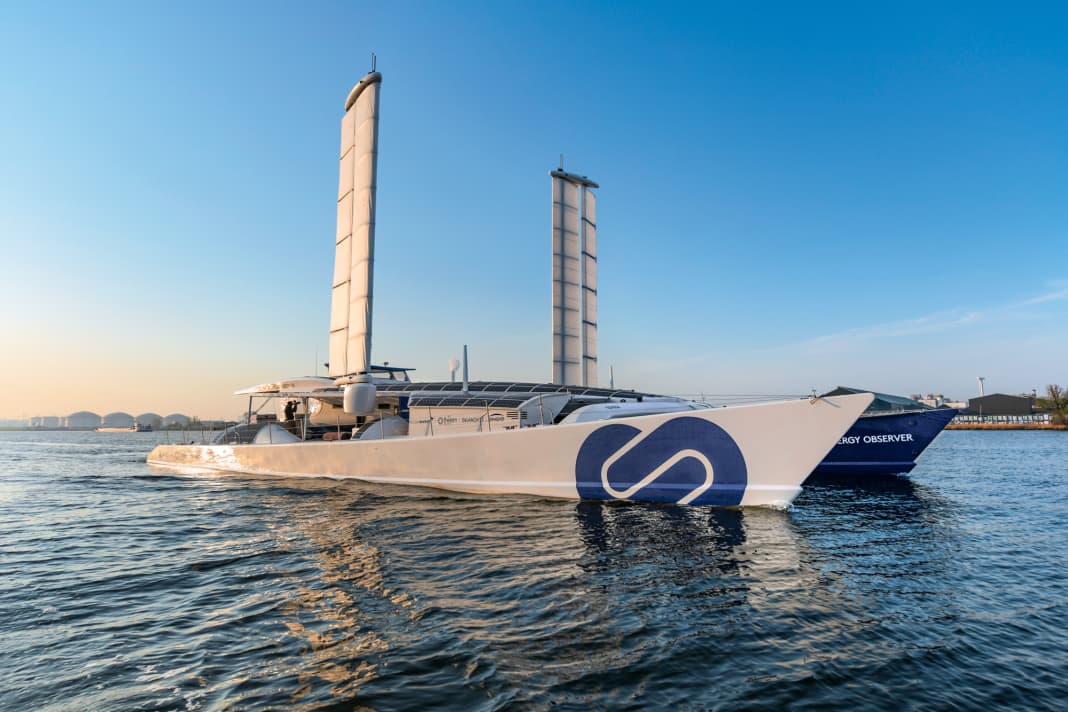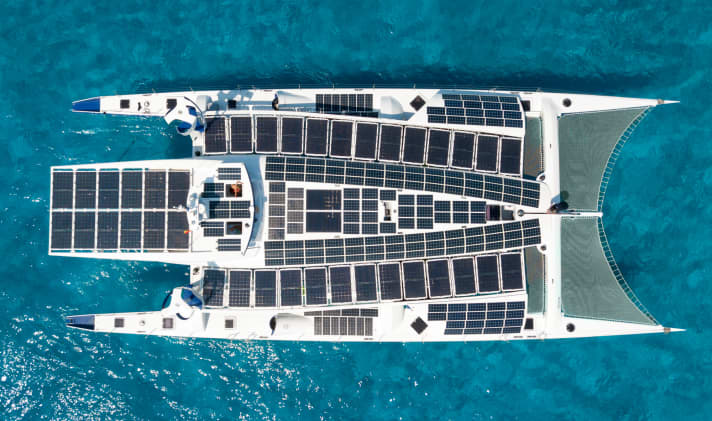





Charleston on the east coast of North America: on 22 May 1819, the 30.5 metre long "Savannah" sets sail for Liverpool. It was to be the first Atlantic crossing by a steamship. But no passengers boarded and no one entrusted the newfangled smoker with cargo, scepticism was too great. The crossing works, but the recoverable paddle wheels are only used for 80 hours during calm periods. A speed of 8 knots is possible with engine power, the rest of the time is spent sailing, the "Savannah" is traditionally rigged. Before Liverpool, the ship is coquettishly heated up once again, and ashore it is believed that a burning ship is coming in.
Exactly 200 years later, the 30.5 metre long "Energy Observer" was moored in Hamburg. Its makers hope that the two razor-sharp prows will point the way to a new age without smoking chimneys. A fuel cell powers the two electric drives. To store their fuel - hydrogen - eight dolphin-thick tanks more than two metres long rest on the foredecks. They each hold 322 litres or almost 8 kilograms of hydrogen at a pressure of 350 bar. The hydrogen waits there for the so-called cold combustion, an electrochemical reaction that produces electricity and heat - as well as water as the only waste product. In this setting, the catamaran resembles a fuel cell or hydrogen car. However, the hydrogen is also produced on board, which is the special feature of this catamaran.
More info:
All the energy for its production, for cooking, for hot water and for the extensive electronics, is generated on board, so far by 165 square metres of solar cells. However, the "Turanor Solar", a 31-metre motor vessel built at the Knierim shipyard in Kiel, has already succeeded in turning the sun into propulsion. It circumnavigated the globe from 2010 to 2012 on the sunny barefoot route. Today it is called "Race for Water", and following a conversion, it also has on-board electrolysis and 200 litres of hydrogen in pressurised tanks. So both projects are travelling in the same direction. The difference, however, lies in the utilisation of wind power. In addition, the "Energy Observer" is the boat with a sailing past.
Their hulls were built in Canada in 1983 as the "Formule Tag", the largest catamaran in the world at the time. Skipper Mike Birch was the first to sail a 500-mile etmal with the carbon fibre monster. Robin Knox-Johnston and Peter Blake gave it a new rig and the sail area was increased from 440 to 526 square metres. The underwater hull was also given a second skin - for safety. On her second attempt, in 1994, the "Enza" successfully circumnavigated the globe in 74 days and 22 hours as part of the Jules Verne Trophy.
From racing goat to research vessel
Tracy Edwards acquired the cat in 1996, from then on it was called "Lady Endeavour", later "Royal Sun Alliance". She started the 1998 Trophée Jules Vernes with a crew of women, but the mast broke on the 43rd day. Toni Bullimore bought and extended the hulls, circumnavigated the globe in "The Race" as "Team Legato" in 2001 and again in 2005 during the "Oryx Quest", again after rechristening, this time as "Team Deadalus". A sale advert from 2008 called for 585,000 British pounds, around 670,000 euros. Apparently, however, no buyer was found. During a transfer in 2009, the ship capsized in the Bay of Biscay in 4 Beaufort winds; no one was injured. In 2013, the "Energy Observer" team acquired the catamaran and converted it for new tasks from 2015.
The ship embarked on its fourth round-the-world voyage using wind and solar power. Victorien Erussard is the initiator of the project. The 44-year-old was active in the French long-distance sailing scene for ten years. Regatta sailing is exciting, but also quite self-centred and doesn't really benefit the rest of the world, says Erussard. "When I had an electrical blackout in the middle of the Atlantic during the Transat Jacques Vabre, the situation felt stupid, while all around me it was bursting with energy from the wind and sun." The power failure on board was the birth of the "Energy Observer" project.
From 2013, Erussard spent two years looking for sponsors, and the conversion took two more. The displacement doubled to 31 tonnes, so the hulls were fitted with buoyancy beads. The wave-deflecting scoops above the companionways in the two hulls have remained. The beams are also the old ones. The nacelle, which at the time was more of a navigation capsule between the aft and centre beams, was replaced by a comparatively opulent centre section extending from fore to aft. Its aerodynamic shape resembles an enormous grain of rice.
"Energy Observer" uses fuel cells and solar energy
"Please close again," appeals Jean Baptiste Sanchez as he enters the rice grain to prevent the Hamburg rain from blowing in. He is one of the three captains of the "Energy Observer", who take turns on the bridge every few weeks. The cat is underway for seven months a year, the rest of the time is spent tinkering. The electrically heated saloon is accessed through the sliding doors, which are quickly closed again. To port is the galley with induction hob and dishwasher, visually floating above the cabin floor thanks to strip lighting, to starboard is the saloon. Forward is the toilet, the five compartments and the shower compartment. 500 litres of hot water are available. The cooling water from the electrolysis heats at 45 degrees, that from the electric motors at 59 degrees and the waste heat from the fuel cell at 72 degrees.
The energy flow is continuously displayed on two screens, just like in a power station. The ten groups of solar cells are symbolised in the upper quarter, fuelling a 400-volt bus via ten chargers. This either feeds the 41,000 watt electric motors directly or the two battery banks: two 56 kilowatt-hour storage units are available at 400 volts. There are also two 24-volt batteries, each with a capacity of 8 kilowatt hours. Calculated on 12 volts, this adds up to over 10,000 ampere hours: 100 car batteries side by side. Another comparison: the hydrogen tanks also store 20 times as much energy, all recorded on the two monitors. "That's my first glance when I get up - and my last before I go to bed."
Continuous optimisation
The energy can also flow directly from the bus into the electrolysis system. The catamaran is already floating in the element. However, a membrane pump must first desalinate the Elbe water. The filtrate is sufficient for noodles and the wet cell, but distilled water is required for electrolysis. For this purpose, it is filtered again in a diaphragm pump. From this system in the port hull, the water passes through a finger-thick stainless steel pipe to the electrolysis system on the starboard side. In principle, electricity is applied to the water, causing the water molecules to split into one hydrogen molecule and one oxygen molecule. Should split.
The "Energy Observer" is not a series production model. Things are constantly being optimised and there are also defects. "The second stage of the compressor needs a new membrane, the twelfth in twelve months," groans Hugo Devedeux, one of the four engineers on board. He hopes to have the new part installed by the time they set sail, as they want to leave with full hydrogen tanks.
"Ocean wings" instead of kite
Although the solar cells supply 24 kilowatts in the optimum case, 14 kilowatts more than required for propulsion, this is not enough to buffer the nights, mornings and evenings. Until the beginning of the year, two wind turbines and a kite were therefore still installed. "The problem, however, was that although the turbines achieved good performance, they also slowed down enormously when travelling against the wind," explains Sanchez. The kite from French manufacturer Beyond the Sea has now also been taken down, as it was difficult to tame, reports Devedeux.
The French design office VPLP from Vannes and Paris is developing wing rigs for cruise and cargo ships, initially tested on a small daysailer tri. The "Energie Observer" has been fitted with the first pair of 30 square metre "Ocean Wings" for a fortnight. The masts only look cute in comparison to the length of the boat, they are twelve metres high. Each wing has two movable segments. This makes them reminiscent of America's Cup rigs on the one hand, but also of the polarising rigs of the planesail and wingsail yachts designed by John Walker at the time, four of which were built between 1997 and 2001. These were built by the Groupe Constructions Industrielles de la Méditerranée (CNIM).
Although there are also control buttons on the two masts for manual operation, they are usually operated from the raised control stand. The canopy is actually made of conventional polyester sailcloth. Hydraulic pistons automatically adjust the wing sections to the course, speed and wind force, while the mast rotates electrically. On the only sailing passage from the Netherlands to Hamburg so far, 10.5 knots were achieved in 20 knots of wind. The turning angle is said to be an incredible 70 degrees, as the cat still has its centreboards from its sailing days.
"Energy Observer" as a generator
In order to get by with the self-generated energy, the cat's electric motor cruising speed is 5 knots. The sails now increase the speed and range, a kind of energy self-sufficient "Danish cruising".
"Next week, the parameters in the charger will be adjusted so that we can also use the motors as generators," enthuses Hugo Devedeux about the planned recuperation. Speed losses of up to 4 knots are expected, with up to 5000 watts flowing into either the batteries or hydrogen production.
The aim is to increase the average speed. The boat was sun-kissed on a Mediterranean tour, stopped off near St Petersburg, round the North Cape to Spitsbergen - and then travelled around the world.
Partner for innovation
Three lorries bring the "Village" to many of the hundred planned harbours. It includes display boards, an office, hemispherical tents for video presentations, lectures and an exhibition. This is made possible by the annual budget of 2.5 million euros. The sponsor's lorries are among the most efficient models available, assures Sanchez. The dinghy, which previously had a combustion engine, will soon be converted to a fuel cell with an electric motor, and a German manufacturer is currently being discussed.
Toyota Europe joined as a partner in 2019. The Japanese company's series-produced fuel cell vehicles would make them a good fit for the portfolio, explains the six-person media department. Toyota, for its part, is hoping to attract more attention to the fuel models, which are seen as more advantageous than battery-powered vehicles. Since 2020, the project has also been focussing on raising awareness of climate change. A key factor in this was reaching Svalbard, where the effects are tangible.
After crossing the Atlantic, the "Savannah" undertook a round trip with stops in Stockholm, St. Petersburg, Kronstadt, Copenhagen and Arendal in Norway. However, the concept was not well received at the time and was a financial disaster. The steam engine was removed and sold, and the "Savannah" sailed as an engine-less freighter until it ran aground off Long Island in 1821 and was dismantled on the spot. 20 years later, regular steamship traffic developed, including across the Atlantic. The "Savannah" was steamed ahead of her time.
Technical data of the "Energy Observer"

- Torso length:30,5 m
- Width:12,8 m
- Depth:2,20 m
- Displacement:31 t
- sail area:2 x 30 m²
- Motor:2 x 41 kW
This article first appeared in YACHT 13/2019 and has been updated for this online version.

